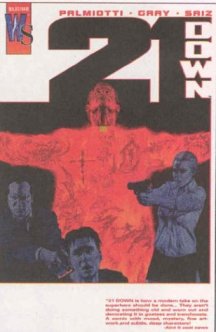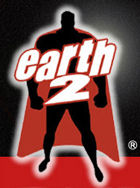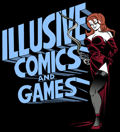| 21
Down: The Conduit
One of
the telling differences between mainstream comics and alternative
press work is the "talking heads" aspect. A lot
of alternative press has comics where very little happens
in way of action or visual dynamics; the story usually comes
through the characters interacting and having dialogues. A
good example would be the difference between the self-published
comic Super Crullers, which was about superheroes in
a coffee shop talking about the intricacies of their job and
featured very little in way of battles and super-wars, and
Common Grounds, the same comic published through Top
Cow, which has to balance the scales between depicting superheroics
and writing "talking heads," to keep the reader
interested.
It makes
sense. Comics are a dual medium that have to balance story
with art. Bad or boring artwork can destroy a good story,
and vice versa. Too many word balloons can mar the panels
of a comic, obscuring characters and leaving no room for action.
Mainstream comics have to pay special attention to this, because
the visual aspect of the comic is half of the reason the comic
sells and sometimes it's the only reason, which explains how
the world ever believed Alex Ross would willingly do a prestige
format oversized comic called Wonder Twins: Form of Water.
Damn your April Fool's antics, Ross!
So, "talking
heads" usually makes for a good cerebral read, but a
poor visual one, which tends to shuffle it off to the Land
of Bad Comics, currently ruled with an iron fist by Chuck
Austen, but thankfully not Iron Fist. I am here today,
boys and girls, to tell you that a comic with spectacular
dialogue, complex plot elements, and great characterization,
but featuring only two really action-oriented scenes, has
been produced…and lo, it is good.
21
Down is the creation of Jimmy Palmiotti, Justin Gray,
and Jesus Saiz. It is the story of Preston Kills, a 20 year-old
tattoo artist who knows he's going to die; not in that ephemeral
"we all go sometime" way, but rather in the "some
enigmatic force will murder me on my 21st birthday" way.
Preston was visited by a mysterious being on his thirteenth
birthday called Herod, that gave him the unique ability to
see the moments just before and just after a person dies.
He is a genie, and has spent the whole of his life trying
to live with his curse, while helping his brother build a
career as a New York City Homicide detective, helping his
brother to close unsolved cases. Accepting his inevitable
death at the hands of Herod, Preston has little interest in
knowing anything more about his abilities, until a friend
convinces him to look it up online. After answering some questions
on an online quiz, things change.
Enter
Mickey Rinaldi: an FBI agent that may have a hidden agenda,
sent to find Preston Kills and other "genies" (those
others touched by Herod), in hopes of discovering who or what
Herod is and stopping him from killing again. She will do
whatever it takes to find Herod, whether Preston likes it
or not.
For those
that recognize the name Herod, that recognition may come from
my review of Gen13: September Song.
The same character that blessed the teens in that comic with
extra-normal powers blessed Preston, and upon a re-reading
I found that Preston Kills actually makes an appearance in
Gen13. The fact that I didn't even notice the connection
until I went back and checked is a testament to Jimmy Palmitotti's
excellent writing.
I talk
a lot about writing good characters and about what makes them
good characters. For me, a good character makes a good book,
and a good cast of characters makes an excellent book (my
main argument for reading Starman).
21 Down has one of the most amazing cast of characters
I've ever had the pleasure of reading. You can tell a good
movie by how well the extras act; the main actor is the one
who wins the award, but the guy who plays a hot dog vendor
and makes the viewer believe that this person could be no
one else but a hot dog vendor is part of what sells the director's
world to the audience.
Palmiotti
has gone a step further than mere characterization to make
Preston and Mickey people. The reader meets Preston at the
point in his life where he's done. He has accepted his death
and tries to enjoy what little of the day his curse allows
him to. But it's not normal to see people's deaths, so Preston
deals with it by going to self-help group for people dying
of cancer. Realistically, this makes absolute sense for Preston.
Who else would understand having an expiration date stamped
on their forehead more than someone whose been told they only
have three months to live? Preston's begrudging participation
with Mickey to uncover information about Herod is simply him
going along with what life gives him.
At the
beginning of the story, Preston is a character that moves
to the beat of the story because he has no direction, no real
will to live. It isn't until the later parts of the collection
that Preston begins to understand the true nature of his power,
and to begin living with no expectation of death. We see him
change from a character playing his part to a character that
drives the story. The depth of the character is what sets
this story apart from others, and once again I am reminded
that Wildstorm has matured so much in its line of comics.
The cast
that surrounds Preston is perfect, not because they fill adequately
the cliché roles one would expect in the plot (the
FBI agent with more questions than answers, the gay friend,
the overbearing brother, etc.) but because they break out
of these roles and become so real to the reader. Mickey appears
at face value to be the femme fatale type that uses sex as
much as a weapon as a semi-automatic, but slowly the reader
becomes aware of the vulnerabilities, the tenacity, and the
driving will that Mickey possesses in her search for Herod.
She isn't bad; she's really just drawn that way.
Other
characters, like Clyde, who could have devolved into some
gay stereotype friend a la Will & Grace, turns
out to be a small but compassionate character that Preston
treats as a brother. His actual brother, Robert, is an equally
multifaceted character; he runs the gamut of demanding older
brother to true friend and noble crusader. Even the old man
Sam that Preston visits fits the role of sagely old grandpa,
while still possessing an air of mystery that echoes the creepiness
of the story.
The story
itself is quiet, in the sense that everything that happens,
happens at it's own pace, with few scenes of large proportion.
The mystery barely begins to unfold as the volume ends, but
we don't mind because the narrative is so damn lush, you forget
about the mystery just before Palmiotti reminds you of some
of the more sinister aspects of the plot. There aren't an
abundance of action sequences, and even the few that exist
are relegated to three or four panels, maybe a page or two.
The things that keep the attention of the reader are eerie
thrill inherent in each scene, and the quiet menace just around
the corner. The tension is what drives the book, as it slowly
builds and comes to a natural and ultimately uplifting perspective
by the end of the volume.
The artwork
is good and it augments the writing rather well. Gray and
Saiz do good work. The lack of action sequences in the book
is somewhat limiting to them, as I believe that if given the
chance, Gray could pencil great and detailed action, as he
has great pacing (he would have to, to match the plot) and
knows how frame his panels and tell a really good visual story.
The sequence near the beginning of the book where Preston
is helping his brother sort through bodies at the World Trade
Center (a flashback to 9/11) is totally silent and it demonstrates
Gray's ability to form a visual narrative.
There's
an introduction to the book by Garth Ennis that, while mentioning
some of the transvestite tendencies of the creators, sums
up why this book is so good, so I leave you all to read Mr.
Ennis' intro after trusting me that this is a spectacular
read. You get a few sketch galleries and the covers are intermittent
throughout the chapters, as well as seven issues worth of
story, all for $19.95. It's the best of talking heads writing
with complimentary artwork, and well worth the price. Go and
buy, fanpeople.
21 Down: The Conduit
|






